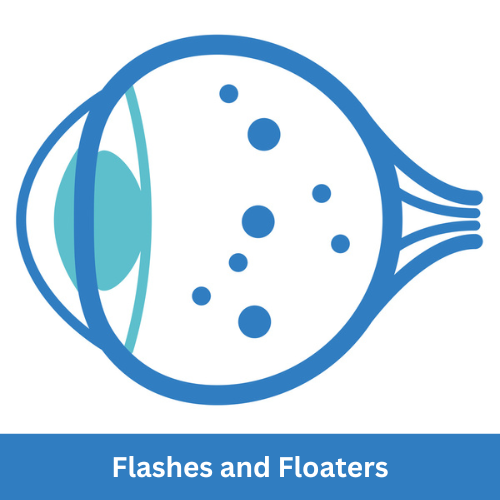Floaters and Flashes: What are they?


Eye floaters are quite common, especially as people age. They are more prevalent in individuals over 50 years old, although they can occur in younger people as well. The prevalence of eye floaters tends to increase with age due to changes in the vitreous humor, the gel-like substance inside the eye.
Vitreous humor is a clear gel that fills the space between the lens of the eye and the retina. As we age, the vitreous can undergo changes in consistency and structure. Small particles or strands can form within the vitreous, casting shadows on the retina, which we perceive as floaters.
While eye floaters are generally harmless, if you suddenly notice a significant increase in the number of floaters or experience flashes of light, it is advisable to seek prompt medical attention. These symptoms could be associated with more serious conditions such as retinal detachment or tears, which require timely intervention. Regular eye exams can help monitor any changes in your vision and address concerns as needed.
The following is a short list of the descriptions, causes, and commonality of eye floaters and flashes of light:
Eye Floaters:
Description: Floaters are tiny specks or “cobweb” -like shapes that seem to drift around in your field of vision. They might look like spots, strands, or squiggly lines.
Cause: Floaters are often caused by small bits of debris or clumps of gel in the vitreous humor casting shadows on the retina. As we age, the vitreous can change consistency, leading to the development of floaters.
Commonality: Many people experience floaters, and they are usually harmless. However, a sudden increase in floaters or the appearance of flashes may signal a more serious issue, and an eye examination is recommended.
Flashes of Light:
Description: Flashes of light are perceived as sudden bright lights or “streaks” that appear in the visual field. They can be brief and intermittent.
Cause: Flashes are often caused by the vitreous humor pulling on the retina. This tugging stimulates the retina, and the brain interprets this stimulation as flashes of light.
Commonality: Similar to floaters, flashes are often a result of changes in the vitreous humor.
However, if you suddenly see a significant increase in flashes or floaters, or if they are accompanied by other symptoms like a shadow or curtain moving across your field of vision, it could indicate a retinal tear or detachment, which requires immediate medical attention.
Associated Conditions:
Retinal Issues: Floaters and flashes may be associated with conditions such as vitreous detachment, where the vitreous humor separates from the retina.
Migraines: Some people experience flashes of light as part of a migraine aura.
It’s important to note that while floaters and occasional flashes are often normal, a sudden increase in their number or the onset of new symptoms should prompt a visit to an eye care professional. Regular eye exams can help monitor and address any changes in your vision.
Gregory Scimeca, M.D.
Ophthalmologist and Medical Director
The Eye Professionals
Our Locations
